|
|
|
|
#1 |
|
Senior Member
Join Date: Nov 2014
Location: UK
Posts: 1,398
|
The young man’s body is splayed in a roadside drain, his face smeared with blood.
Sydney Morning Hearld March 15 2020. Caught running drugs from Myanmar into Thailand, he was shot by police who say he opened fire on them with a nine-millimetre handgun. The corpse is examined by a forensics team, watched from the road above by nearly two dozen police and soldiers who chatter behind a line of plastic yellow police tape. 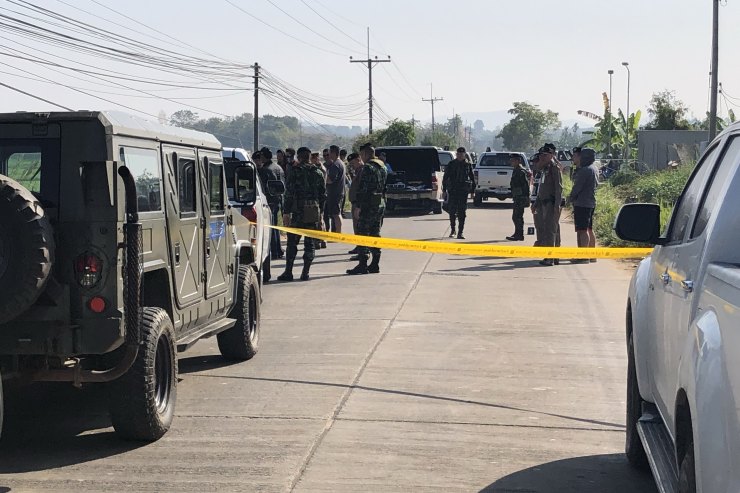 Thai police and soldiers watch as a forensics team examine the body of an alleged drug runner. As the cool morning haze evaporates, his death barely disturbs the surge of life all around. A farmer tends his nearby rice paddy; a child plays outside her home a mere hundred metres from the crime scene. On Thailand’s northern border with Myanmar the war on drugs and gunfights are a mundane evil. This day in January will be scored as a victory for the law but the loss of a small drug shipment and one of many dirt-poor foot soldiers or “pirates” will be chalked up as a minor inconvenience to the warlords, drug barons and their silent partners in politics who make an estimated $45 billion to $90 billion a year from the South-east Asian drug trade. The trafficker’s silver Ford pickup is filled with 400,000 tiny “Yaba” or “madness drug” pills, the cheap mix of methamphetamine and caffeine preferred by workers from Thailand to the Philippines. Each orange pill is about the size of the head of a straw and bears a “WY” stamp, marking it as manufactured by the United Wa State Army, one of many militias which operate beyond the control of Myanmar's ruling junta. In what has been described as the world’s longest-running civil war, a bewildering array of ethnic armed organisations have been fighting the country’s military on and off for 70 years. In Myanmar’s north-eastern Shan State, warlords finance their armies by making narcotics in partnership with transnational organised crime syndicates. It’s been much the same since the country won independence from British rule in 1948. The only thing that has changed is the product: opium fields have given way to even more lucrative “ice” factories. Among the dead man’s cargo in Thailand are two distinctive green packets of “Guanyinwang” Chinese tea. To those who know what to look for it’s a sign of quality. Inside each foil wrap is a kilo of high-grade crystal methamphetamine, largely made for export to more lucrative markets like Australia. It’s estimated that up to 70% of the methamphetamine on Australia’s streets is cooked up in Myanmar. But it’s just part of a complex and shadowy production and distribution web. The base drugs, or precursors, largely come from China, shipped from legitimate chemical factories in hundreds of tonnes each year. The cash raised from drug sales is laundered through more than 200 casinos that have grown like a cancer through Myanmar, Laos and Cambodia over the last decade. The narcotics are then shipped by air and sea through a sophisticated logistics network to the streets of Australia. The Golden Triangle is the meeting point of three countries - Myanmar, Thailand and Laos - and it has long been the gateway for the region’s drug trade. It’s the perfect witch's brew of geography, crime and political interests that allows the drug trade to flourish. And it’s an industry that cannot possibly exist on this scale without the tacit or active support of some governments in the region. Myanmar At a police checkpoint an hour’s drive north-west of Myanmar’s old royal capital Mandalay, trucks and cars rumbling south are cycled through a mobile X-ray machine. The unit has intercepted tonnes of narcotics and precursors since it was installed. This disruption of drug profits made it a target of militia forces in August. The strike with a rocket launcher didn’t destroy the unit but, in a running battle, the retreating militia force killed more than a dozen police and soldiers. Australian Federal Police liaison officer Jared Taggart is in his last week of a four-year posting working with Myanmar police. The AFP has a two-decade-long association with the country that began with attempts to stem the heroin trade. He admires his counterparts, saying that despite pitiful pay they are fighting on the front line in a battle that helps defend Australia. “It's very highly likely that 60 to 70% of the methamphetamines we see in our community … have emanated from Myanmar-based production,” he says. He reels off the wins for law enforcement: “In the last four years, our joint activities with Myanmar police force have resulted in the seizure of more than 22 tonnes of narcotics and 680 tonnes of precursor chemicals. That's more than $2 billion worth of drugs not making it to the shores of Australia. And that's probably more than 52 million hits of drugs that haven't made it into our community.” But with wastewater analysis showing Australians spent a staggering $8.6 billion in 2019 buying more than 11 tonnes of meth, this thin blue frontline is catching raindrops in a thunderstorm. At a police base on the outskirts of Mandalay, Taggart leads a tour through a wired-off compound about the size of a basketball court; a quarter of its concrete floor is covered by industrial-sized drums holding 60 tonnes of chemicals used in the production of ice. The primary ingredients in methamphetamine are ephedrine and pseudoephedrine. To make the illicit narcotic they have to be dissolved in a slush of solvents like drain cleaners, phosphorus, sulphuric and hydrochloric acid. Every kilo of meth yields five kilos of stinking toxic sludge that’s flushed into the jungle. “I think our community in Australia doesn't really have a strong sense of the harmful products that are going into what many may perceive to be very pure drugs,” Taggart says. “These are really base poisonous, harmful chemicals.” 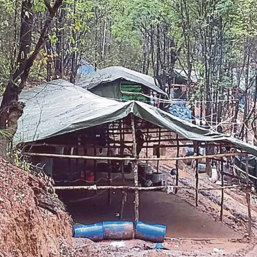 A drug lab in the Myanmar jungle. The only thing more toxic than the drug labs of Myanmar is the politics that makes it all possible. The country is awash with warring interests, which has left a large swath of Shan State under the control of dozens of ethnic armed organisations and militias. Among the litany of peace deals and uneasy truces one was struck in the 1980s between the ruling military and the country’s most powerful ethnic armed group, the United Wa State Army, which would have a dramatic effect on the drug trade. The essence of the agreement was captured in a report by the United States Institute of Peace as the United Wa State Army pledging to “not fight against government forces in exchange for the freedom to pursue whatever business activities it chose”. It chose to cultivate opium. The report noted that deal “enabled the UWSA to build a drug empire that outmatched anything [Myanmar] had seen”. The United Wa State Army’s most profitable drug is now meth, and the billions it makes fund an army of more than 20,000 men. It has strong links with the Chinese Communist Party and its weapons, like most of the chemicals it uses for meth production, come from China. It’s arsenal includes Chinese-made surface-to-air missiles, heavy artillery and armoured fighting vehicles. An International Crisis Group report last year noted that “the drugs trade would not be possible without high-level corruption in those countries – including China, Laos and Thailand - through which large consignments of drugs or their precursors are smuggled. “China has a particular responsibility to prevent precursor smuggling; it is the main source of these chemicals, but has almost never intercepted shipments crossing its border with Myanmar.” Laos The Golden Triangle Special Economic Zone is 3000 hectares of agricultural land on the Laos side of the Mekong River, leased for 50 years to the Hong Kong-based Kings Romans Group. It is one of 14 economic zones embraced by the cash-strapped Lao government and now incorporated as part of China’s “Belt and Road” initiative to link Asia to Europe by land and sea. The group’s chief executive, Chinese businessman Zhao Wei, won the land on a promise of jobs and prosperity. But the US Treasury has declared Zhao’s main business is running a transnational criminal syndicate. It has sanctioned Zhao and his associates for facilitating “the storage and distribution of heroin, methamphetamine and other narcotics for illicit networks, including the United Wa State Army”. The group is also accused of “an array of horrendous illicit activities” like child prostitution and sex slavery. Zhao denies the allegations. 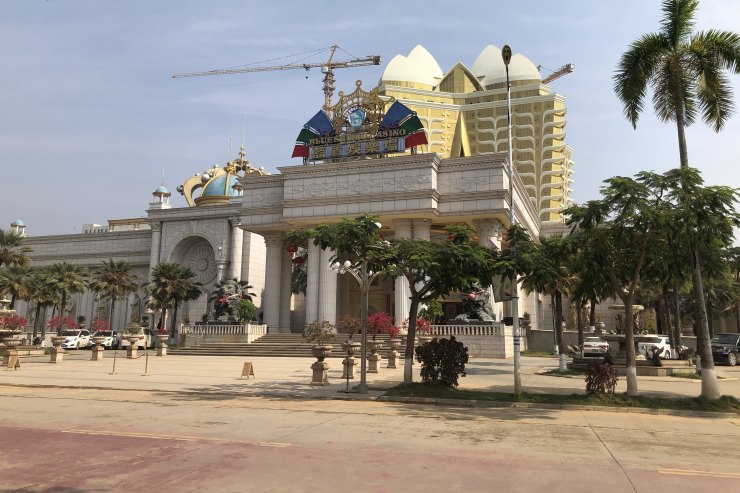 The Kings Romans Casino in the Golden Triangle Special Economic Zone in Laos. Cranes crowd the horizon over the zone and at its heart is the Kings Romans Casino, which lures Chinese punters from a homeland where gambling is illegal. Its gaudy crown rises on the banks of the Mekong in the shadow of a massive golden hotel that’s under construction. Inside the casino is a gauche collision of faux-classical European frescoes and statues. All the tables in one wing were devoted to a popular Asian card game, Tiger-Dragon, but this day there are few players and bored croupiers are falling asleep at empty tables. Kings Romans is also notorious for trafficking endangered animals. Laos has declared the tiger extinct in the wild but there are tigers here - hidden from view and farmed for their body parts. Some restaurants in the zone once advertised tiger and bear on the menu until bad publicity from international organisation the Environmental Investigation Agency forced that trade underground and a tiger compound next to the casino was moved. After several attempts we find an extremely nervous taxi driver who is willing to take us to the new, larger tiger farm. Past a quarry on the edge of the zone a narrow dirt road ends at a high-walled compound that rises up the side of a hill. The guard waves me off as I approach on foot and knows enough English to confirm that he is not Lao but “Burmese”. He is familiar with another English word. “Is this the tiger zoo?” “Yes,” he nods. “Are there many tigers in here?” “Yes.” Standing on the Thai side of the Mekong, Jeremy Douglas, regional representative for the United Nations' Office on Drugs and Crime, doesn’t hide his contempt for Zhao Wei’s handiwork as he stares at the building just a few hundred metres away. “It's an abomination, frankly,” he says. He’s tracked the dismal rise of it and the other casinos that have bloomed in Myanmar, Laos and Cambodia, all aiming to draw Chinese cash. “This is really in essence a massive governance failure,” Douglas says. “What we're looking at is some parts of some countries are not under control of government, so basically it's a free space for organised crime to do their business. "And then of course you have places, like across the river here, where you can launder the money and then you have the market on this side. So it's got all the elements that organised crime needs to really do their work.” In three days spent on the border with Thai military and narcotics police, they make it clear that they believe they are battling both government failure in Myanmar and a Laos government that is patron to a criminal enterprise. They show photographs of Zhao Wei in the front rank of a gathering of regional drug enforcement chiefs. An honoured guest of the Lao delegation, he arrived in an armour-plated Land Rover with six bodyguards and donated money to the regional war on drugs. “Do you have any doubt that Zhao Wei is involved in the drug trade?” I ask the senior Thai narcotics officer who is scrolling through the pictures of the businessman and his entourage on his phone. “Yes, of course he is,” he laughs. 'The more they lose the more they produce' Seedy is too bland a description of the hotel in the Myanmar border town of Tachileik where we have arranged to meet a local drug dealer. The room stinks of stale cigarettes and in an ironic touch the wall over the bed is decorated with a painting of opium poppies. This is a place that does not try to hide its associations. The dealer wears a black-and-red mask for the camera. He’s a relatively young man in his mid-thirties but his eyes have the faraway glaze of someone whose hope is lost. He describes a world where the people who run the drug trade are untouchable, protected by their own armies, their wealth and their government connections. He doesn’t believe the trade can be stopped, saying he’s never seen a single “holiday” in trafficking. “The more they lose the more they produce,” he says. While drug pirates are being shot and small dealers arrested, no warlords and few drug lords ever face justice. But the AFP are tracking some of the big players. In June Australian Border Force officials found 1.6 tonnes of ice hidden in stereo speakers in sea cargo that arrived in Melbourne from Bangkok. It had an estimated street value of $1 billion. Much of the consignment was wrapped in the distinctive Guanyinwang tea packaging, marking it as made in Myanmar. The seizure was linked to a drug tsar who first appeared on police's radar in 2011, Chinese-born Canadian Tse Chi Lop. Police have dubbed his network of five triads “Sam Gor”, for Tse’s Cantonese nickname “Brother Number Three”. The AFP believes Tse leads the largest crime syndicate running drugs into Australia and he is the key target of an international investigation dubbed Operation Kungur. RELATED ARTICLE A record 1.2 tonnes of methamphetamine has been seized on the west coast of Australia and eight men have been charged as a result of a complex, multi-agency investigation which traversed the country. It is the largest meth bust in Australia?s history, topping an unrelated 903-kilogram seizure in Melbourne in the first quarter of 2017. It is the largest ever drug seizure in Western Australia. The Western Australian Joint Organised Crime Task Force (WA JOCTF) has been working in close partnership since July to dismantle a drug trafficking network, believed to be based in Australia. The WA JOCTF involves the Australian Federal Police (AFP), Western Australia Police Force, Australian Border Force (ABF), AUSTRAC, and the Australian Criminal Intelligence Commission. It also received assistance from members of the Department of Home Affairs. Police will allege in court a marine vessel, the?Valkoista, arrived at the Port of Geraldton, WA, around 2am WST yesterday (Thursday, 21 December 2017). Drugs 'Like a global corporation': Hunting down Asia's El Chapo “If that group controls, give or take, 50 to 70% of the crystal meth trade hitting the streets of Australia, then they would be making $US8 billion a year,” the UN’s Jeremy Douglas says. “And he of course would be the biggest player in that group. So we're talking about billionaires.” Police have dubbed a group of five known associates of Tse “The Billionaires' Club”. Former AFP officer Roland Singor first identified Tse and says the meth trade in South-east Asia is now so big and profitable that rival groups have joined forces. “There were a lot of turf wars between them and they've now come together as a united multinational corporate entity, if you like,” Singor says. “They have management centres throughout South-east Asia.” Singor says the syndicate’s operations are structurally separated so that the compromise of one unit does not affect the others. “They're very cellular,” he says. “They have their own project teams and they answer back to Tse Chi Lop and his core group. And he answers to a broader community of investors and business partners.” Douglas hints that some of those business partners include governments. “We're seeing some countries of this region essentially ceding bits of sovereignty, whether it's the special economic zone here or the parts of Shan State, these other special economic zones and casino zones that are popping up,” Douglas says. “These guys are buying parts of the region.” Inside the Golden Triangle, where warlords and drug barons... smh.com.au›world/asia…golden-triangle…20200310… 31 V 2023. |
|
|
#2 |
|
Senior Member
Join Date: Nov 2014
Location: UK
Posts: 1,398
|
http://https://youtu.be/tL6pJITOGwY Drug Trafficking, Politics and Power...Era of Empires From colonial China’s opium wars to Cold War US politics, we trace the rise of the global drug trade and its political backers. Opium, heroin, morphine and cocaine – behind these infamous drug names lies a complex story of colonial power, wealth accumulation and power politics dating from the 1790s to 1970s. At the turn of the 19th century, colonial powers in Asia actively encouraged opium use and promoted its spread throughout the region. Meanwhile, the Western pharmaceutical industry developed other miraculous products, used for medicine at first: morphine and later cocaine and heroin. Drug Trafficking, Politics and Power Part 1 - YouTube WebFrom colonial China’s opium wars to Cold War US politics, we trace the rise of the global drug trade and its political backers.Opium, heroin, morphine and co... A MUST WATCH. |
|
|
#3 |
|
Senior Member
Join Date: Jun 2012
Posts: 3,110
|
It's the fucking Americans who set the Golden Triangle up as the world centre of opium production for much of the late 20th century, though. You have to remember that. This is all very well-documented. Just another example of ZOG's strategy of using every piece of filth in the world to do their dirty work backfiring on them.
|
|
|
#4 |
|
Senior Member
Join Date: Nov 2014
Location: UK
Posts: 1,398
|
Afghanistan: Opium Supply Drops by 95% After Taliban Ban
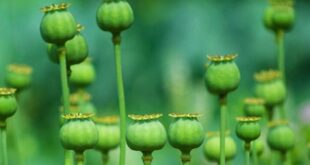 For people that are supposedly Iron Age savages, the Taliban seem to be pretty good at actually enforcing laws. Where in the “civilized world” has any government managed to get these kinds of results on illegal drugs? Or maybe they’re not even trying?  Just whack it with a stick. Opium production in Afghanistan has plummeted since the Taliban banned cultivation of the poppy plant, according to a UN report published on Sunday. Afghanistan’s Taliban rulers pledged to wipe out the country’s drug industry, banning poppy cultivation in April 2022. Poppy plants are the source of opium and heroin. Afghanistan was the world’s biggest opium producer and a major source for heroin in Europe and Asia before the Taliban takeover. What did the report on Afghan opium production say? The report by the United Nations Office on Drugs and Crime (UNODC) found that poppy cultivation had dropped by an estimated 95% over the past year, from 233,000 hectares (575,755 acres) at the end of 2022 to 10,800 hectares in 2023. Opium production also dropped from 6,200 tons to 333 tons in 2023. According to the report, this year’s harvest amounts to 24-38 tons of exportable heroin, much less than the 350-580 tons estimated for 2022. Farmer’s incomes have fallen by 92% this year, from an estimated $1.36 billion to $110 million. In 2022, poppy crops made up almost a third by value of total agricultural production in Afghanistan. The UNODC warned of the risk of people previously involved in the opium industry moving towards other illegal activities, like the trafficking of arms, people or synthetic drugs. A September report from the same agency said that Afghanistan was the world’s fastest-growing producer of methamphetamine. If that’s actually true, I’m sure when the Taliban crack down on meth, they’re gonna get similar results. These are serious people. The UNODC said the Taliban crackdown on the poppy industry could have a negative impact on many Afghans’ livelihoods and warned of “humanitarian consequences for many vulnerable rural communities.” “Today, Afghanistan’s people need urgent humanitarian assistance… to absorb the shock of lost income and save lives,” UNODC Executive Director Ghada Waly said. Waly said other crops, such as cotton and wheat, were far more water-intensive than poppy plants. She added that Afghanistan had undergone “three years of consecutive drought.” “Afghanistan is in dire need of strong investment in sustainable livelihoods to provide Afghans with opportunities away from opium,” she said. If you’re a junkie, do not be alarmed. Myanmar is making a return to the opium business. Afghanistan: Opium Supply Drops by 95% After Taliban Ban 08 XI 2023. Fact the bid 3 are: The International: Oil, Drugs, Guns & Kissinger Associates tariganter.wordpress.com›2011/09/17/the-… Through every major scandal and behind every despotic regime stands a global financial oligarchy- ultimate beneficiary of the world’s addiction to oil, guns and drugs. The oil wealth generated in the Persian Gulf region is the main source of capital for these bankers. Just business. Fentyanal is the big one today. |
|
|
#5 |
|
Senior Member
Join Date: Nov 2014
Location: UK
Posts: 1,398
|
Afghanistan Loses Title of World’s Top Opium Producer Under Taliban
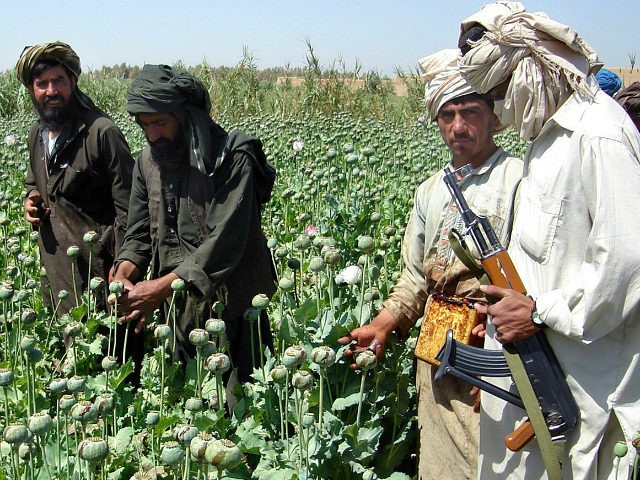 The United Nations Office of Drugs and Crime (UNODC) published a report Tuesday that revealed, according to its estimates, Myanmar is now the world’s top producer of opium, dethroning longtime leader Afghanistan. Afghanistan has maintained a reputation as a global hub for opium, heroin, and other opioid drugs for decades, largely as a result of the Taliban cultivating poppy to fund its war against America and the former Afghan government doing little to contain the opium trade. Poppy is one of the most lucrative crops in Afghanistan, leading impoverished farmers to use their land to grow the plant used to produce opium. The Taliban terrorist organization seized control of the country in August 2021, ousting the American-backed government, and claimed it would make Afghanistan “narcotics free.” In 2022, Taliban jihadists announced a ban on poppy cultivation that initially led to a documented boom in production, but according to the UNODC report published on Tuesday, it has since resulted in a 95% decline in 2023 production estimates. In addition to banning poppy cultivation, the Taliban launched a campaign to abduct heroin addicts and force them into brutal “rehabilitation” centers in which they were reportedly deprived of the drug abruptly, a dangerous and potentially deadly practice for addicts. Tuesday’s UNODC report focused largely on neighboring Myanmar and Laos. Myanmar, in particular, the United Nations documented, has seen a dramatic increase in opium production following the 2021 military coup. The increase in production, UNODC stated, is partially a result of the industry in the country becoming “increasingly sophisticated,” moving away from the model of small family farms. “Sowing poppy in densely organized plots and use of other inputs, such as irrigation systems, and sometimes fertilizers, have recently boosted plot yields and total production estimates to historic levels,” the report detailed. “Following several years of decline between 2014 and 2020, poppy cultivation in Myanmar reached a low of 29,500 hectares in 2020,” the organization explained: While the trend ended in 2021 with a slight increase from the year before, the 2022 growing season – the first one following the military takeover in February 2021 – saw a large increase of about 33%, with cultivation estimates reaching just over 40,000 hectares. Speaking to Voice of America, UNODC Regional Representative Jeremy Douglas said on Tuesday that “the instability and lack of security in Myanmar have caused really significant economic turmoil the past couple of years, resulting in people turning to other ways to make money.” “So, essentially, people that had options before, when the economy was doing comparatively well, are going back to opium production,” he explained. “It’s basically an income earner for them when they have few or no other options.” Myanmar is currently seeing its highest opium production since 2001. The country reportedly produced 1,080 tons of opium in 2023, which the BBC noted was “far ahead of the 330 tonnes Afghanistan reportedly produced.” The United Nations attributed the decline in production in Afghanistan to the Taliban’s cultivation ban. 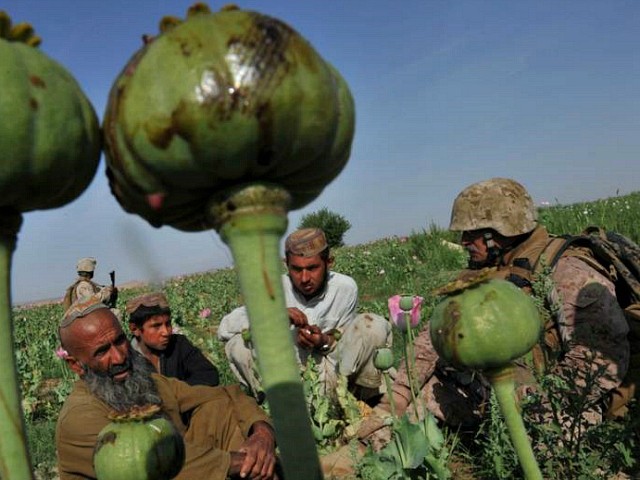 Rudy Ayala (R), a law enforcement professional embedded with the Marine Corps, questions opium poppy farmer Abdul Manan (L) and his two sons, Hastihan (R2) and Muhammad Bayan (L2), at Maranjan village in Helmand province, Afghanistan, on April 25, 2011. “In 2022, the de facto authority in Afghanistan reimposed a strict ban on poppy cultivation and opium production, resulting in a 95% decline in production estimates in 2023,” the report stated. The United Nations refuses to accept the Taliban as the formal government of Afghanistan, instead referring to it as the “de facto authority.” “This development, if sustained, could result in global shortages of opiates, including heroin, given Afghanistan’s historically dominant role in illegal production of opium,” the UNODC report continued. “A global shortage in opiates, including heroin, could result in upward pressure on the price of opium in the region, which would likely encourage more cultivation and production from Southeast Asia.” In the Taliban’s first press conference following the fall of Kabul, spokesman Zabihullah Mujahid insisted that the terrorists would eradicate the drug trade. “From now on, Afghanistan will be a narcotics-free country,” Mujahid proclaimed. He later added, “We are assuring our countrymen and women and the international community that Afghanistan will not produce any kind of narcotics.” At the time, Afghanistan was responsible for “more than 80% of global morphine and heroin” seized by police each year, according to UNODC, and the Taliban itself was part of the reason why. “The Taliban have counted on the Afghan opium trade as one of their main sources of income,” Cesar Gudes, the head of UNODC’s Kabul office, told Reuters in August 2021. The Taliban took over half a year to officially ban opium production in April 2022, which reportedly led to a slight increase in production before a decline. By November 2023, UNODC documented a 95% drop in opium in the country. Many farms switched to growing wheat, the United Nations reported, but wheat crops are far cheaper than opium, and the abrupt shift could lead to an increase in poverty rates in what is already one of the world’s poorest nations. Who needs heroin from Afghanistan, when we have fentanyl from China and Mexico. 1) The Taliban originally stamped out the poppies 90% and it didn't take very long by making the farmers an offer they couldn't refuse. 2) US-NATO invades and occupies Afghanistan and within two years poppy production is back up to bumper crop status as US-NATO troops stand guard. 3) The CIA is the largest drug running operation in the world. 4) Pull your heads out. Afghanistan Loses Title of World’s Top Opium Producer Under Taliban. 12 XII 2023. World Industries: 1) Oil, 2) Guns from pistols to Nukes, 3) Drugs narcotics to big Pharma. |
 |
| Share |
«
Previous Thread
|
Next Thread
»
| Thread | |
| Display Modes | |
|
|
All times are GMT -5. The time now is 11:06 PM.
Page generated in 0.40264 seconds.



 Linear Mode
Linear Mode
